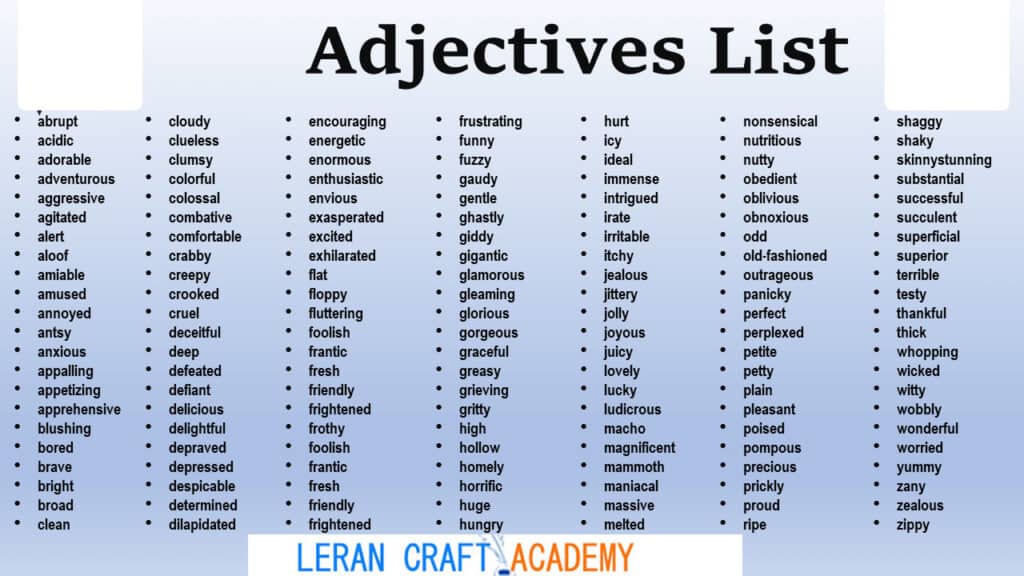Introduction
Adjectives are the spice of the English language. They add color, depth, and detail to our communication, making our expressions more vivid and engaging. Whether you’re a beginner or looking to enhance your writing skills, understanding adjectives is crucial.

Understanding Adjectives
Definition and Role
Adjectives are words that describe or modify nouns and pronouns. They provide additional information about an object’s size, shape, age, color, origin, or material. For example, in the phrase “a red apple,” the word “red” is an adjective describing the apple.
Types of Adjectives
Adjectives come in various forms, each serving a unique purpose in a sentence. The main types include descriptive, quantitative, demonstrative, possessive, interrogative, and indefinite adjectives.
Descriptive Adjectives
Examples and Usage
Descriptive adjectives, also known as qualitative adjectives, describe the qualities of a noun. They tell us more about an object’s characteristics. Examples include “beautiful,” “large,” “old,” and “blue.”
Enhancing Descriptions
Using descriptive adjectives can make your sentences more engaging. Instead of saying, “She has a dog,” you can say, “She has a small, playful dog.” The adjectives “small” and “playful” provide a clearer image of the dog.
Quantitative Adjectives
Expressing Quantity
Quantitative adjectives describe the quantity of something. They answer questions like “how much” or “how many.” Examples include “some,” “few,” “many,” and “several.”
Examples and Usage
For example, in the sentence “She has three cats,” the word “three” is a quantitative adjective indicating the number of cats.
Demonstrative Adjectives
Pointing Out Specific Items
Demonstrative adjectives are used to point out specific nouns. They include “this,” “that,” “these,” and “those.”
Examples and Usage
In the sentence “That book is mine,” the word “that” is a demonstrative adjective specifying which book is being referred to.
Possessive Adjectives
Indicating Ownership
Possessive adjectives show ownership or possession. Common possessive adjectives include “my,” “your,” “his,” “her,” “its,” “our,” and “their.”
Examples and Usage
For instance, in “This is my house,” the word “my” is a possessive adjective indicating that the house belongs to the speaker.
Interrogative Adjectives
Asking Questions
Interrogative adjectives are used in questions. They include words like “which” and “what.”
Examples and Usage
In the question “Which color do you prefer?” the word “which” is an interrogative adjective modifying the noun “color.”
Indefinite Adjectives
Non-Specific Descriptions
Indefinite adjectives describe nouns in a non-specific manner. Examples include “any,” “many,” “few,” and “several.”
Examples and Usage
For example, in “Many people attended the concert,” the word “many” is an indefinite adjective describing an unspecified number of people.
Order of Adjectives
Proper Sequence in Sentences
When multiple adjectives are used together, they generally follow a specific order: quantity, quality, size, age, shape, color, origin, material, purpose. For instance, “She bought two big, old, round, red, Italian, wooden dining tables.”
Examples and Usage
Following the correct order ensures clarity and fluency in sentences. Saying “two big, old, round, red, Italian, wooden dining tables” is clearer than “wooden big red two old Italian round dining tables.”
Degrees of Comparison
Positive, Comparative, Superlative
Adjectives can change form to show different degrees of comparison. The positive degree describes one item, the comparative compares two, and the superlative compares three or more.
Examples and Usage
For example:
- Positive: “smart”
- Comparative: “smarter”
- Superlative: “smartest”
Common Mistakes with Adjectives
Typical Errors
Learners often mix up the order of adjectives or use the wrong form in comparative and superlative degrees.
Tips for Improvement
Practice using adjectives in sentences, pay attention to their order, and regularly review the rules for degrees of comparison.
Advanced Adjective Usage
Complex Sentences
In advanced writing, adjectives are used in more complex sentences to add depth and detail. For example, “The intricately designed, beautifully colored vase sat on the antique wooden table.”
Nuanced Descriptions
Adjectives can provide subtle nuances in descriptions, helping to convey specific emotions or imagery.
Adjectives in Literature
Enhancing Storytelling
Authors use adjectives to paint vivid pictures in the reader’s mind, adding depth to characters, settings, and events.
Examples from Literature
Consider Charles Dickens’ description of Scrooge: “a squeezing, wrenching, grasping, scraping, clutching, covetous, old sinner.”
Teaching Adjectives to Beginners
Effective Strategies
Use visual aids, interactive activities, and consistent practice to help beginners learn adjectives.
Fun Activities and Games
Games like “Adjective Bingo” or “Descriptive Drawing” can make learning fun and engaging.
Conclusion
Adjectives are a fundamental part of the English language, enriching our communication by providing detailed descriptions. Practice using different types of adjectives, understand their order, and apply them in various contexts to enhance your language skills.
FAQs
What are adjectives?
Adjectives are words that describe or modify nouns and pronouns, providing additional information about an object’s size, shape, age, color, origin, or material.
How can I improve my use of adjectives?
To improve, practice using adjectives in sentences, pay attention to their order, and regularly review the rules for degrees of comparison.
Are there any tricks to remember the order of adjectives?
A common trick is to remember the acronym “OSASCOMP” (Opinion, Size, Age, Shape, Color, Origin, Material, Purpose) to help recall the correct order.
What is the difference between descriptive and demonstrative adjectives?
Descriptive adjectives describe the qualities of a noun, while demonstrative adjectives point out specific nouns.
Can adjectives change in form?
Yes, adjectives can change form to show different degrees of comparison: positive, comparative, and superlative.